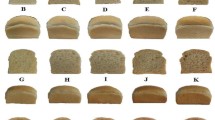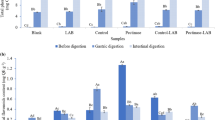Abstract
The aim of this work was to evaluate the influence of enzymatic hydrolysis on dietary fiber, phenolic compounds and technological properties of apple pomace as wheat bread supplement. Apple pomace was hydrolyzed with Viscozyme® L, Pectinex® Ultra Tropical, Celluclast® 1.5 L for 1 and 5 h. Soluble (SDF) and insoluble (IDF) dietary fiber, reducing sugars and the total phenolic contents (TPC), along with the technological properties (water and oil retention capacities, solubility index, emulsion stability) of treated apple pomace were evaluated. The prebiotic activity of apple pomace water-soluble fraction on two probiotic strains Lactobacillus acidophilus DSM 20079 and Bifidobacterium animalis DSM 20105 was investigated. Treatment with Celluclast® 1.5 L increased SDF, reducing sugars, SDF/IDF ratio and decreased IDF of apple pomace. While treatment with Viscozyme® L, Pectinex® Ultra Tropical increased reducing sugars, solubility index and TPC, but in most cases reduced oil and water retention capacities, decreased SDF and IDF content. All apple pomace extracts promoted growth of probiotic strains. Addition of 5% of apple pomace hydrolyzed with Celluclast® 1.5 L did not have negative impact on wheat bread, while addition of other enzymatically hydrolyzed apple pomaces decreased pH, specific volume and porosity of wheat bread. Obtained results suggest that apple pomace enzymatically hydrolyzed with Celluclast® 1.5 L can be potentially used for wheat bread supplementation with dietary fiber.
Similar content being viewed by others
Data Availability
All data generated or analyzed during this study are included in this published article and its supplementary information files.
References
Kruczek M, Drygas B, Habryka C (2016) Pomace in fruit industry and their contemporary potential application. World Sci News 48:259–265
Reis SF, Rai DK, Abu-Ghannam N (2014) Apple pomace as a potential ingredient for the development of new functional foods. Int J Food Sci Technol 49:1743–1750. https://doi.org/10.1111/IJFS.12477
Vendruscolo F, Albuquerque PM, Streit F et al (2008) Apple pomace: a versatile substrate for biotechnological applications. Crit Rev Biotechnol 28:1–12. https://doi.org/10.1080/07388550801913840
FDA authors (2008) Health claims: fruits, vegetables, and grain products that contain fiber, particularly soluble fiber, and risk of coronary heart disease. In: Code of Federal Regulations. https://www.ecfr.gov/current/title-21/chapter-I/subchapter-B/part-101/subpart-E/section-101.77. Accessed 28 May 2022
Schneeman BO (1987) Soluble vs insoluble fiber: different physiological responses. Food Technol 47:81–82
Masoodi FA, Chauhan GS (1998) Use of apple pomace as a source of dietary fiber in wheat bread. J Food Process Preserv 22:255–263. https://doi.org/10.1111/J.1745-4549.1998.TB00349.X
Gómez M, Martinez MM (2018) Fruit and vegetable by-products as novel ingredients to improve the nutritional quality of baked goods. Crit Rev Food Sci Nutr 58:2119–2135. https://doi.org/10.1080/10408398.2017.1305946
Elleuch M, Bedigian D, Roiseux O et al (2011) Dietary fibre and fibre-rich by-products of food processing: characterisation, technological functionality and commercial applications: a review. Food Chem 124:411–421. https://doi.org/10.1016/J.FOODCHEM.2010.06.077
Garcia-Amezquita LE, Tejada-Ortigoza V, Serna-Saldivar SO, Welti-Chanes J (2018) Dietary fiber concentrates from fruit and vegetable by-products: processing, modification, and application as functional ingredients. Food Bioprocess Technol 11:1439–1463. https://doi.org/10.1007/S11947-018-2117-2
de Camargo AC, Regitano-D’Arce MAB, Biasoto ACT, Shahidi F (2016) Enzyme-assisted extraction of phenolics from winemaking by-products: antioxidant potential and inhibition of alpha-glucosidase and lipase activities. Food Chem 212:395–402. https://doi.org/10.1016/J.FOODCHEM.2016.05.047
Borujeni NE, Karimi K, Denayer JFM, Kumar R (2022) Apple pomace biorefinery for ethanol, mycoprotein, and value-added biochemicals production by Mucor indicus. Energy 240:122469. https://doi.org/10.1016/J.ENERGY.2021.122469
Barreira JCM, Arraibi AA, Ferreira ICFR (2019) Bioactive and functional compounds in apple pomace from juice and cider manufacturing: potential use in dermal formulations. Trends Food Sci Technol 90:76–87. https://doi.org/10.1016/J.TIFS.2019.05.014
Dranca F, Oroian M (2019) Optimization of pectin enzymatic extraction from malus domestica ‘fălticeni’ apple pomace with celluclast 1.5L. Molecules 24:2158. https://doi.org/10.3390/MOLECULES24112158
Wikiera A, Mika M, Starzyńska-Janiszewska A, Stodolak B (2015) Application of Celluclast 1.5L in apple pectin extraction. Carbohydr Polym 134:251–257. https://doi.org/10.1016/J.CARBPOL.2015.07.051
Li X, He X, Lv Y, He Q (2014) Extraction and functional properties of water-soluble dietary fiber from apple pomace. J Food Process Eng 37:293–298. https://doi.org/10.1111/JFPE.12085
Zheng HZ, Hwang IW, Chung SK (2009) Enhancing polyphenol extraction from unripe apples by carbohydrate-hydrolyzing enzymes. J Zhejiang Univ Sci B 10:912–919. https://doi.org/10.1631/JZUS.B0920186
Martínez Sabajanes M, Yáñez R, Alonso JL, Parajó JC (2012) Pectic oligosaccharides production from orange peel waste by enzymatic hydrolysis. Int J Food Sci Technol 47:747–754. https://doi.org/10.1111/J.1365-2621.2011.02903.X
Gómez B, Yáñez R, Parajó JC, Alonso JL (2016) Production of pectin-derived oligosaccharides from lemon peels by extraction, enzymatic hydrolysis and membrane filtration. J Chem Technol Biotechol 91:234–247. https://doi.org/10.1002/JCTB.4569
Min B, Lim J, Ko S et al (2011) Environmentally friendly preparation of pectins from agricultural byproducts and their structural/rheological characterization. Bioresour Technol 102:3855–3860. https://doi.org/10.1016/J.BIORTECH.2010.12.019
Lim J, Yoo J, Ko S, Lee S (2012) Extraction and characterization of pectin from Yuza (Citrus junos) pomace: a comparison of conventional-chemical and combined physical–enzymatic extractions. Food Hydrocoll 29:160–165. https://doi.org/10.1016/J.FOODHYD.2012.02.018
Liu H, Wei X, Zu S et al (2021) Separation and identification of neutral oligosaccharides with prebiotic activities from apple pectin. Food Hydrocoll 121:107062. https://doi.org/10.1016/J.FOODHYD.2021.107062
Antonic B, Jancikova S, Dordevic D, Tremlova B (2020) Apple pomace as food fortification ingredient: a systematic review and meta-analysis. J Food Sci 85:2977–2985. https://doi.org/10.1111/1750-3841.15449
Alongi M, Melchior S, Anese M (2019) Reducing the glycemic index of short dough biscuits by using apple pomace as a functional ingredient. LWT-Food Sci Technol 100:300–305. https://doi.org/10.1016/J.LWT.2018.10.068
Figuerola F, Hurtado ML, Estévez AM et al (2005) Fibre concentrates from apple pomace and citrus peel as potential fibre sources for food enrichment. Food Chem 91:395–401. https://doi.org/10.1016/J.FOODCHEM.2004.04.036
Paganini C, Nogueira A, Silva NC, Wosiacki G (2005) Utilization of apple pomace for ethanol production and food fiber obtainment. Ciência e Agrotecnologia 29:1231–1238. https://doi.org/10.1590/S1413-70542005000600018
Diñeiro García Y, Valles BS, Picinelli Lobo A (2009) Phenolic and antioxidant composition of by-products from the cider industry: Apple pomace. Food Chem 117:731–738. https://doi.org/10.1016/J.FOODCHEM.2009.04.049
Toledo NMV, Mondoni J, Harada-Padermo SS et al (2019) Characterization of apple, pineapple, and melon by-products and their application in cookie formulations as an alternative to enhance the antioxidant capacity. J Food Process Preserv 43:e14100. https://doi.org/10.1111/JFPP.14100
Dongowski G, Sembries S (2001) Effects of commercial pectolytic and cellulolytic enzyme preparations on the apple cell wall. https://doi.org/10.1021/JF001410
Sabater C, Corzo N, Olano A, Montilla A (2018) Enzymatic extraction of pectin from artichoke (Cynara scolymus L.) by-products using Celluclast®1.5L. Carbohydr Polym 190:43–49. https://doi.org/10.1016/J.CARBPOL.2018.02.055
Yoon KY, Cha M, Shin SR, Kim KS (2005) Enzymatic production of a soluble-fibre hydrolyzate from carrot pomace and its sugar composition. Food Chem 92:151–157. https://doi.org/10.1016/J.FOODCHEM.2004.07.014
Gama R, van Dyk JS, Pletschke BI (2015) Optimisation of enzymatic hydrolysis of apple pomace for production of biofuel and biorefinery chemicals using commercial enzymes. 3 Biotech 5:1075–1087. https://doi.org/10.1007/s13205-015-0312-7
Nadar SS, Rao P, Rathod VK (2018) Enzyme assisted extraction of biomolecules as an approach to novel extraction technology: a review. Food Res Int 108:309–330. https://doi.org/10.1016/J.FOODRES.2018.03.006
Huang F, Liu H, Zhang R et al (2019) Physicochemical properties and prebiotic activities of polysaccharides from longan pulp based on different extraction techniques. Carbohydr Polym 206:344–351. https://doi.org/10.1016/J.CARBPOL.2018.11.012
Calvete-Torre I, Sabater C, Antón MJ et al (2022) Prebiotic potential of apple pomace and pectins from different apple varieties: modulatory effects on key target commensal microbial populations. Food Hydrocoll 133:107958. https://doi.org/10.1016/J.FOODHYD.2022.107958
Altermann E, Russell WM, Azcarate-Peril MA et al (2005) Complete genome sequence of the probiotic lactic acid bacterium Lactobacillus acidophilus NCFM. Proc Natl Acad Sci USA 102:3906–3912. https://doi.org/10.1073/pnas.0409188102
Acknowledgements
The authors acknowledge Novozymes A/S, Denmark, for kindly providing the enzymes required for this research.
Funding
No funds, grants, or other support was received.
Author information
Authors and Affiliations
Contributions
Jolita Jagelaviciute: Conceptualization, methodology, investigation, original draft preparation, review and editing; Guste Staniulyte: Investigation; Dalia Cizeikiene: methodology, review and editing; Loreta Basinskiene: Supervision, review and editing.
Corresponding author
Ethics declarations
Competing interests
The authors declare no competing interests.
Ethics approval
Not applicable.
Conflict of Interest
The authors declare no conflict of interest.
Additional information
Publisher’s Note
Springer Nature remains neutral with regard to jurisdictional claims in published maps and institutional affiliations.
Electronic Supplementary Material
Below is the link to the electronic supplementary material.
Rights and permissions
Springer Nature or its licensor (e.g. a society or other partner) holds exclusive rights to this article under a publishing agreement with the author(s) or other rightsholder(s); author self-archiving of the accepted manuscript version of this article is solely governed by the terms of such publishing agreement and applicable law.
About this article
Cite this article
Jagelaviciute, J., Staniulyte, G., Cizeikiene, D. et al. Influence of Enzymatic Hydrolysis on Composition and Technological Properties of Apple Pomace and Its Application for Wheat Bread Making. Plant Foods Hum Nutr 78, 307–313 (2023). https://doi.org/10.1007/s11130-023-01054-w
Accepted:
Published:
Issue Date:
DOI: https://doi.org/10.1007/s11130-023-01054-w




